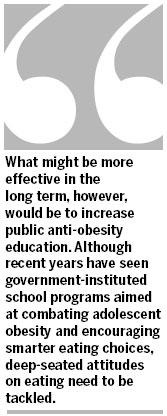Hard lesson to stomach
Updated: 2013-02-01 13:24
By Michael Barris (China Daily)
|
||||||||

This past fall, in a move that outraged and mystified many local residents and businesspeople, New York's board of health took on the growing US obesity problem by voting to ban the sale of big sodas and other sugary drinks at city restaurants, street carts and movie theaters.
Michael R. Bloomberg, the city's outspoken mayor, declared the move would save an estimated 5,800 lives lost annually through obesity-related health issues, as well as $4 billion in related medical costs.
Thus did the Big Apple try to take a big bite out of obesity rates that have been blamed for killing 100,000 to 400,000 Americans annually and running up about $117 billion in costs related to medical treatment and lost worker productivity. America's obesity tab accounts for 6 to 12 percent of all US healthcare costs, with the disease now affecting 17 percent of all US children and adolescents.
But New York's big soft-drink ban, the first of its kind in the US, is less about keeping people from eating things that are bad for them than it is about teaching portion control, an often-neglected topic here.
Want proof? Step into any diner in the New York area and behold the tables crowded with platters of food, overflowing with helpings of steak, pasta, fish or chicken, often smothered in cheese and accompanied by huge orders of French fries. Conceivably, each plate holds enough food to feed two people, but sharing rarely is practiced in these parts. Swayed by the prospect of a bargain - getting a lot of food for what is perceived as a relatively low price - and the visual allure of the spread laid before them, patrons often will eat most, if not all, of what is there. Simply put, the bigger the portion, the more people will eat, as the scholar Barbara Rolls and her research team concluded from a study in 2000 of adult eaters.
But restaurants aren't the only culprits in the portion-size problem: grocery stores, convenience stores and drug stores also provide ample opportunity for the public to buy chips, soda, candy bars and other items in large, multiple-size servings. Go to any of these places and you will discover it is a lot harder to find any of these items in smaller sizes.
China, which is now confronting its own obesity problems, can learn from US mistakes. As higher living standards lead to increased food intake, some Chinese cities - particularly those where fast-food consumption has become a way of life - now have as much as a 20 percent obesity rate.
In 2003, obesity among Chinese adults translated into direct medical costs of 21.1 billion yuan ($3.4 billion). Meanwhile, urban Chinese boys are 6.6 pounds heavier on average than they were 30 years ago, according to Ministry of Health statistics. By 2007, Ji Chengye, director of the Institute of Child and Adolescent Health Medical Center at Peking University, had found that the obesity rate among children and adolescents in Beijing, Shanghai and other major Chinese cities had matched that of developed countries. No wonder Matthew Crabbe, co-author of Fat China: How Expanding Waistlines are Changing a Nation, has called China's obesity rates a "ticking bomb".
Sure, you could find other factors to blame for China's obesity problem. Rapid motorization, for instance, has drastically reduced levels of cycling and walking in the country. And with the one-child policy, it is easier for Chinese parents and grandparents to indulge a young person's every food whim.
But food intake seems inarguably at the heart of the obesity problem. If it wanted to follow Mayor Bloomberg's hard line on big soft drinks, the Chinese government could raise the price on big helpings of certain foods, in an attempt to influence people to consume smaller portions.
What might be more effective in the long term, however, would be to increase public anti-obesity education. Although recent years have seen government-instituted school programs aimed at combating adolescent obesity and encouraging smarter eating choices, deep-seated attitudes on eating need to be tackled.
With statistics from the Chinese Center for Disease Control and Prevention showing that obesity now affects 120 million people under 18, a concerted effort needs to be made to show people, and youths in particular, how to feed themselves responsibly - and to get them to see that obesity should not be mistaken for prosperity.

 In Photos: 7.0-magnitude quake hits Sichuan
In Photos: 7.0-magnitude quake hits Sichuan
 Li Na on Time cover, makes influential 100 list
Li Na on Time cover, makes influential 100 list
 FBI releases photos of 2 Boston bombings suspects
FBI releases photos of 2 Boston bombings suspects
 World's wackiest hairstyles
World's wackiest hairstyles
 Sandstorms strike Northwest China
Sandstorms strike Northwest China
 Never-seen photos of Madonna on display
Never-seen photos of Madonna on display
 H7N9 outbreak linked to waterfowl migration
H7N9 outbreak linked to waterfowl migration
 Dozens feared dead in Texas plant blast
Dozens feared dead in Texas plant blast
Most Viewed
Editor's Picks

|

|

|

|

|

|
Today's Top News
Live report: 7.0-magnitude quake hits Sichuan, heavy casualties feared
Boston suspect cornered on boat
Cross-talk artist helps to spread the word
'Green' awareness levels drop in Beijing
Palace Museum spruces up
First couple on Time's list of most influential
H7N9 flu transmission studied
Trading channels 'need to broaden'
US Weekly

|

|







